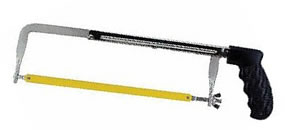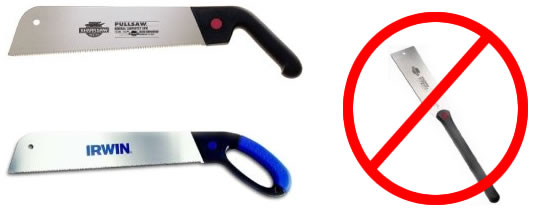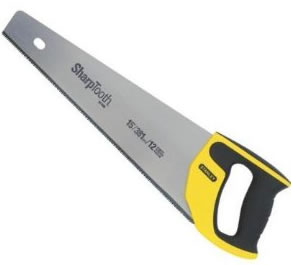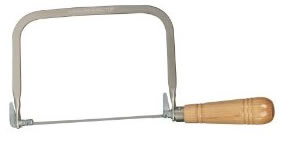When your child is ready to use a handsaw, safety should be the first requirement. Secure the wood with clamps, vises or kid friendly miter-box. Kids should be taught to keep both hands on the saw or one hand behind their back. That will eliminate nearly all potential sawing injuries.
With that out of the way the question comes to what saw is the right saw for them. As with all woodworking took choices, there are quite a few choices.

Hack saws made for cutting metal are actually a good starter wood saw for kids. The teeth are small and not overly aggressive. This makes it easy to start and easy to move back and forth. The teeth are hardened to will stand up to a fair amount of abuse and still cut fairly well. The blade is not very deep so it does not get stuck in the wood as easily as a typical wood saw. As an added bonus, the saw blade can be flipped around so it can be changed to cut either on the push stroke, or the pull stroke. Be sure to get one that tensions the blade on both ends, not one of the flimsy ones where the end of the blade is not supported. Great Neck and Stanley both offer good affordable hack saws. Replacement blades are abundant and inexpensive. When they are ready to use a real wood saw, this one can serve it’s real purpose of cutting metal and will be a tool that could last their lifetime.

Pull-saws come in a variety of shapes and sizes and have teeth that cut on the pull stroke. The teeth are usually sharper than traditional saws and the blades are thinner, which means they cut easier and faster. I recommend the carpenter style saws that have teeth on just one side. The double sided Ryoba saws are handy with one side set for rip cutting and the other for crosscut, but the presence of teeth on both sides of the blade is a bit more of a safety risk for kids. Good yet affordable pull saws are made by Shark and Irwin. The one drawback to pull saws is that the teeth are sharp and fairly easily damaged if misused.

Toolbox Saws are short and generally have a thicker blade which makes them very sturdy. I am a big fan of the Stanley 15″ yellow toolbox saw. The yellow plastic handle makes it look like a toy, but it is not. The teeth cut on both the push and pull stroke so it cuts fast and easily. The blade guard is secure and completely covers the teeth so it protects them from kids who pick up and put away their tools roughly. This is a good saw for kids, and while you are ordering them one, get a second for yourself. You’ll be amazed at how often you need it.

Coping Saws or Jig Saws are best avoided for kids. The blades often bind and break when used by young kids. They take more practice than parents realize and a gentler hand to make them work effectively. Many parents make the mistake of starting their kids with a coping saw because they look smaller and more manageable for kids, but any of the other saws above are a better choice.
Better Sawing for Kids
Regardless of the type of saw you choose for your child it is important that children (and their parent) understand that sawing is actually a gentle act. Many kids get the wrong impression from watching their parents that sawing is an aggressive, forceful thing…the harder you push the faster you cut. The tighter you grip the saw, the faster you cut. These are both false. A saw should pushed and pulled gently to allow the teeth to do the work. A saw should be gripped lightly, not tightly. The general rule is that when you are sawing, if anything is clenched (teeth, hands, butt) you are doing something wrong in your approach to sawing.
Related Articles
No user responded in this post